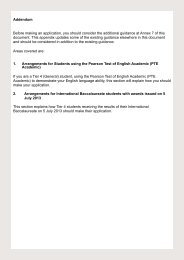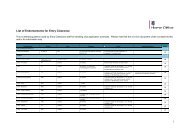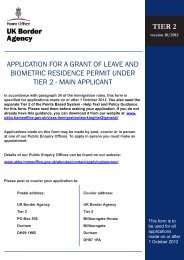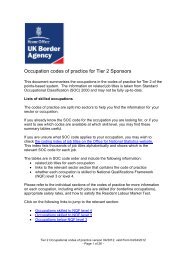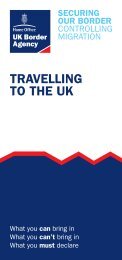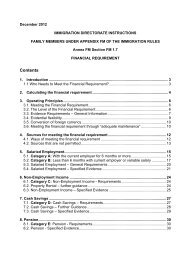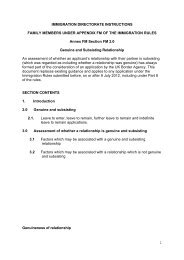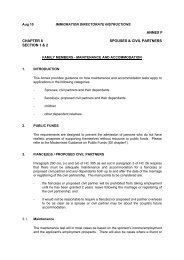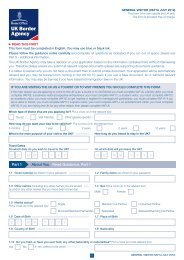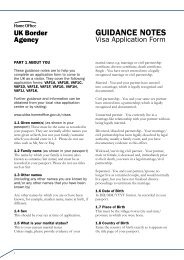COI Report March 2012 - UK Border Agency - Home Office
COI Report March 2012 - UK Border Agency - Home Office
COI Report March 2012 - UK Border Agency - Home Office
Create successful ePaper yourself
Turn your PDF publications into a flip-book with our unique Google optimized e-Paper software.
SRI LANKA 7 MARCH <strong>2012</strong><br />
From the departure area there are three security entrances to the check-in area. The gate to the<br />
right caters for passengers departing on Sri Lankan Airlines; the gate to the left is for<br />
passengers on all other airlines and the gate in between is for staff only. The security guards<br />
ask passengers for evidence of ticketing and will only allow persons to pass who have produced<br />
this. Persons holding a ‗day pass‘ are not allowed into the check-in area. Immediately behind<br />
these security checks, a sign indicates ‗Customs‘. A customs officer is often seen in the vicinity,<br />
but it is not a permanent presence. Likewise, there are scanners for baggage but these are<br />
rarely seen in operation.<br />
At the check-in desks, passengers have to produce their passports to airline staff and go<br />
through check-in procedures. Airline check-in staff routinely check the identity of the person<br />
against the passport details, the validity of the passport, and if the passenger has the<br />
appropriate visa for their country of destination or transit. Having checked-in, passengers then<br />
proceed to a security gate, where they produce their passport and boarding card in order to<br />
enter the Department of Immigration & Emigration (DIE) area. All passengers must complete a<br />
departure card and then queue at an immigration officer‘s desk. Passengers must present their<br />
passport, departure card and boarding pass to the immigration officer. The immigration officer<br />
scans the details page of the passport on the DIE <strong>Border</strong> Control System database. Three<br />
scanned images of the details page appear on the computer screen in normal light, ultra-violet<br />
and infrared, in order to identify if the document has been forged or tampered with in any way.<br />
Non Sri Lankans will be checked against any existing database records and officers will check<br />
arrival endorsements in the passport. Passports belonging to all passengers i.e. Sri Lankan and<br />
foreign nationals, are endorsed with an immigration officer‘s embarkation stamp. Once through<br />
the immigration control, passengers proceed to the main departure lounge.<br />
The Department of Immigration & Emigration (DIE) are notified only when a Court decides to<br />
impound the suspect‘s passport or an arrest warrant is issued. The details of such persons<br />
would be placed on their alert or wanted list within their database. There is no other mechanism<br />
to ensure that the Immigration <strong>Office</strong>rs are aware of such instances. Apart from these Court<br />
powers, Immigration <strong>Office</strong>rs have no power in law to prevent persons embarking. The other<br />
method, which is rare and case specific, is that the State Intelligence Service (SIS) can inform<br />
Immigration <strong>Office</strong>rs of individuals suspected of terrorist activity and those on a wanted list.<br />
Again the details of suspects would be put on the DIE database. Without Court sanction,<br />
Immigration officers are powerless to put an individual in detention if they are otherwise satisfied<br />
that they have a right to enter or live in Sri Lanka. The State Intelligence Service (SIS) has an<br />
office adjacent to the immigration embarkation control and DIE officials can refer embarking<br />
passengers to them if they think it necessary.<br />
Further security checks are conducted when passengers arrive at the boarding gate. Hand<br />
baggage and belongings, including mobile phones and shoes, are passed through a scanner.<br />
Passengers proceed through a scanner and are frisked depending on whether the alarm is<br />
activated. There is then a further boarding card check conducted by airline staff prior to<br />
entering the holding lounge. On many flights with European destinations, plus some with<br />
onward connections to Europe, North America and Australia, Airline Liaison <strong>Office</strong>rs from<br />
several overseas missions and/or trained airline document checkers make further checks on<br />
passenger‘s passports to check their admissibility in their transit and /or destination countries.<br />
Entry Procedures<br />
Arriving passengers should be provided with a Department of Immigration & Emigration arrival<br />
card by the carrying airline. Depending on which stand the aircraft has arrived at, arriving<br />
passengers will either walk from the gate on the main pier, or be deposited by bus from outlying<br />
252 The main text of this <strong>COI</strong> <strong>Report</strong> contains the most up to date publicly available information as at 3 February <strong>2012</strong>.<br />
Further brief information on recent events and reports has been provided in the Latest News section<br />
to 2 <strong>March</strong> <strong>2012</strong>.



